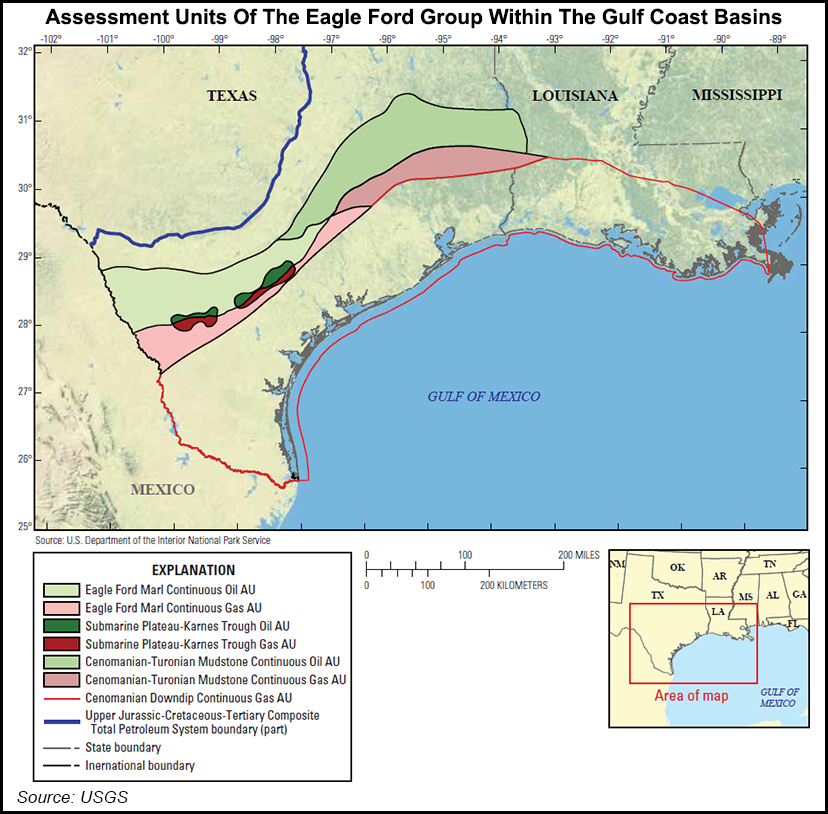E&P | Eagle Ford Shale | NGI All News Access | NGI The Weekly Gas Market Report
Eagle Ford Holds Miles and Miles of Natural Gas and Oil, Says USGS
The Eagle Ford Group in Texas is rich in oil and natural gas, a unique feature for U.S. onshore plays and ranking among the top five in the country, according to a new assessment.

The U.S. Geological Survey (USGS) estimated the play holds undiscovered, technically recoverable resources totaling 8.5 billion bbl of oil, 66 Tcf of natural gas and 1.9 billion bbl of natural gas liquids. The updated estimate consists of resources in continuous accumulations.
“This assessment is a bit different than previous ones, because it ranks in the top five of assessments we’ve done of continuous resources for both oil and gas,” said USGS scientist Kate Whidden, the report’s lead author. “Usually, formations produce primarily oil or gas, but the Eagle Ford is rich in both.”
Continuous oil and gas is dispersed throughout a geologic formation rather than existing as discrete, localized occurrences, such as those in conventional accumulations. Because of that, continuous resources commonly require special technical drilling and recovery methods, such as hydraulic fracturing.
“Texas is so well known for its history of oil and gas production that it’s almost synonymous with petroleum,” said USGS Director Jim Reilly. “Texas continues to remain in the forefront of our nation’s energy supply chain with remarkable increases in production and reserves due to the revolutionary unconventional techniques used to release previously unrecoverable resources.”
The “Eagle Ford Group,” as USGS describes it rather than only as a “shale” play, stretches from the Texas-Mexico border to the west, across portions of South and East Texas to the Texas-Louisiana border to the east. The play is comprised of mudstone, with varying amounts of carbonate.
The Eagle Ford long has been known to contain oil and gas, but it was not until 2008 that production in the formation ramped up in the East Texas portion of the play, which many producers refer to as the Upper Eagle Ford and Eaglebine.
“Seven continuous assessment units (AU) were defined for the Eagle Ford Group and associated Cenomanian–Turonian strata across the study area, based on lithology, stratal thickness, thermal maturity, regional geologic features, and spatial distribution of productive fairways,” the report said.
AUs within a total petroleum system are defined by strata that share similar structural and petroleum-charge histories along with lithology and stratigraphy.
The USGS assessed oil and gas resources for six continuous AUs in the Eagle Ford Group and associated Cenomanian–Turonian strata in the Gulf Coast region of Texas. The assessment determined the Eagle Ford is one of the top five largest continuous resources for both oil and gas assessed in the United States.
“The Eagle Ford Group contains one of the most prolific continuous accumulations of oil and gas in the United States; its composition is predominantly mudstone and calcareous mudstone (marl) with organic-rich intervals,” according to the report.
Undiscovered resources are those that are estimated to exist based on geologic knowledge and statistical analysis of known resources, while technically recoverable resources can be produced using available technology and industry practices. Whether or not it is profitable to produce the resources was not evaluated.
The USGS provides “unbiased assessments of U.S. and global energy resources,” said Reilly. “We regularly reassess potential resources, as we have for the Eagle Ford in this report, in response to changes in estimated ultimate recovery as new techniques or productive horizons are pioneered.”
© 2024 Natural Gas Intelligence. All rights reserved.
ISSN © 2577-9877 | ISSN © 1532-1266 | ISSN © 2158-8023 |
